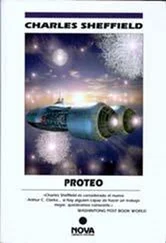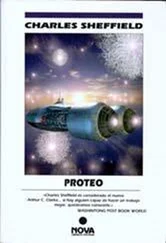Supersymmetry, in a particular form known as superstring theory , offers another possible source of hidden mass. This one is easily the most speculative. Back at a time, 10 -43seconds A.C., when gravity decoupled from everything else, a second class of matter may have been created that is able to interact with normal matter and radiation, today, only through the gravitational force. We can never observe such matter, in the usual sense, because our observational methods, from ordinary telescopes to radio telescopes to gamma ray detectors, all rely on electromagnetic interaction with matter.
This “shadow matter” produced at the time of gravitational decoupling lacks any such interaction with the matter of the familiar Universe. We can determine its existence only by the gravitational effects it produces, which, of course, is exactly what we need to “close the Universe,” and also exactly what we needed for the fifth chronicle.
One can thus argue that the fifth chronicle is all straight science; or, if you are more skeptical, that it and the theories on which it is based are both science fiction. I think that I prefer not to give an opinion.
* * *
In mathematics and physics, an invariant is something that does not change when certain changes of condition are made. For example, the “connectedness” or “connectivity” of an object remains the same, no matter how we deform its surface shape, provided only that no cutting or merging of surface parts is permitted. A grapefruit and a banana have the same connectedness — one of them can, with a little effort, be squashed to look like the other (at least in principle, though it does sound messy). A coffee cup with one handle and a donut have the same connectedness; but both have a different connectedness from that of a two-handled mug, or from a mug with no handle. You and I have the same connectedness — unless you happen to have had one or both of your ears pierced, or wear a ring through your nose.
The “knottedness” of a piece of rope is similarly unchanging, provided that we keep hold of the ends and don’t break the string, There is an elaborate vocabulary of knots. A “knot of degree zero” is one that is equivalent to no knot at all, so that pulling the ends of the rope in such a case will give a straight piece of string — a knot trick known to every magician. But when Alexander the Great “solved” the problem of the Gordian Knot by cutting it in two with his sword, he was cheating.
Invariants may sound useless, or at best trivial. Why bother with them? Simply for this reason: they often allow us to make general statements, true in a wide variety of circumstances, where otherwise we would have to deal with lots of specific and different cases.
For example, the statement that a partial differential equation is of elliptic, parabolic, or hyperbolic type is based on a particular invariant, and it tells us a great deal about the possible solutions of such equations before we ever begin to try to solve them. And the statement that a real number is rational or irrational is invariant, independent of the number base that we are using, and it too says something profound about the nature of that number.
What about the invariants of physics, which interested McAndrew? Some invariants are so obvious, we may feel they hardly justify being mentioned. For example, we certainly expect the area or volume of a solid body to be the same, no matter what coordinate system we may use to define it.
Similarly, we expect physical laws to be “invariant under translation” (so they don’t depend on the actual position of the measuring instrument) and “invariant under rotation” (it should not matter which direction our experimental system is pointing) and “invariant under time translation” (we ought to get the same results tomorrow as we did yesterday). Most scientists took such invariants for granted for hundreds of years, although each of these is actually making a profound statement about the physical nature of the Universe.
So, too, is the notion that physical laws should be “invariant under constant motion.” But assuming this, and rigorously applying it, led Einstein straight to the theory of special relativity. The idea of invariance under accelerated motion took him in turn to the theory of general relativity.
Both these theories, and the invariants that go with them, are linked inevitably with the name of one man, Albert Einstein. Another great invariant, linear momentum, is coupled in my mind with the names of two men, Galileo Galilei and Isaac Newton. Although the first explicit statement of this invariant is given in Newton’s First Law of Motion ( “Every body will continue in its state of rest or of uniform motion in a straight line except in so far as it is compelled to change that state by impressed force.” ), Galileo, fifty years earlier, was certainly familiar with the general principle.
Some of the other “great invariants” needed the efforts of many people before they were firmly defined and their significance was appreciated. The idea that mass was an invariant came about through the efforts of chemists, beginning with Dalton and Lavoisier, who weighed combustion products and found that the total was the same before and after. The equivalence of different forms of energy (heat, motion, potential energy, and electromagnetic energy), and the invariance of total energy of all forms, developed even later. It was a combined effort by Count Rumford, Joule, Maxwell, Lord Kelvin, Helmholtz and others. The merger of the two invariants became possible when Einstein showed the equivalence of mass and energy, after which it was only the combined mass-energy total that was conserved.
Finally, although the idea that angular momentum must be conserved seems to arise naturally in classical mechanics from the conservation of linear momentum, in quantum physics it is much more of an independent invariant because particles such as protons, neutrons, electrons, and neutrinos have an intrinsic, internal spin, whose existence is not so much seen as deduced in order to make angular momentum a conserved quantity.
This sounds rather like a circular argument, but it isn’t, because intrinsic spin couples with orbital angular momentum, and quantum theory cannot make predictions that match experiments without both of them. And as McAndrew remarks, Wolfgang Pauli in 1931 introduced the idea of a new particle to physics, the neutrino, just in order to preserve the laws of conservation of energy and momentum.
There are other important invariants in the quantum world, However, some things which “common sense” would insist to be invariants may be no such thing. For example, it was widely believed that parity (which is symmetry upon reflection in a mirror) must be a conserved quantity, because the Universe should have no preference for left-handed sub-nuclear processes over right-handed ones. But in 1956, Tsung Dao Lee and Chen Ning Yang suggested this might not be the case, and their radical idea was confirmed experimentally by C.S. Wu’s team in 1957. Today, only a combination of parity, charge, and time-reversal is regarded as a fully conserved quantity.
Given the overall importance of invariants and conservation principles to science, there is no doubt that McAndrew would have pursued any suggestion of a new basic invariant. But if invariants are real, where is the fiction in the sixth chronicle? I’m afraid there isn’t any, because the nature of the new invariant is never defined.
Wait a moment, you may say. What about the Geotron?
That is not fiction science, either, at least so far as principles are concerned. Such an instrument was seriously proposed a few years ago by Robert Wilson, the former director of the Fermilab accelerator. His design called for a donut-shaped device thirty-two miles across, in which protons would be accelerated to very high energies and then strike a metal target, to produce a beam of neutrinos. The Geotron designers wanted to use the machine to probe the interior structure of the Earth, and in particular to prospect for oil, gas, and valuable deep-seated metal deposits.
Читать дальше












